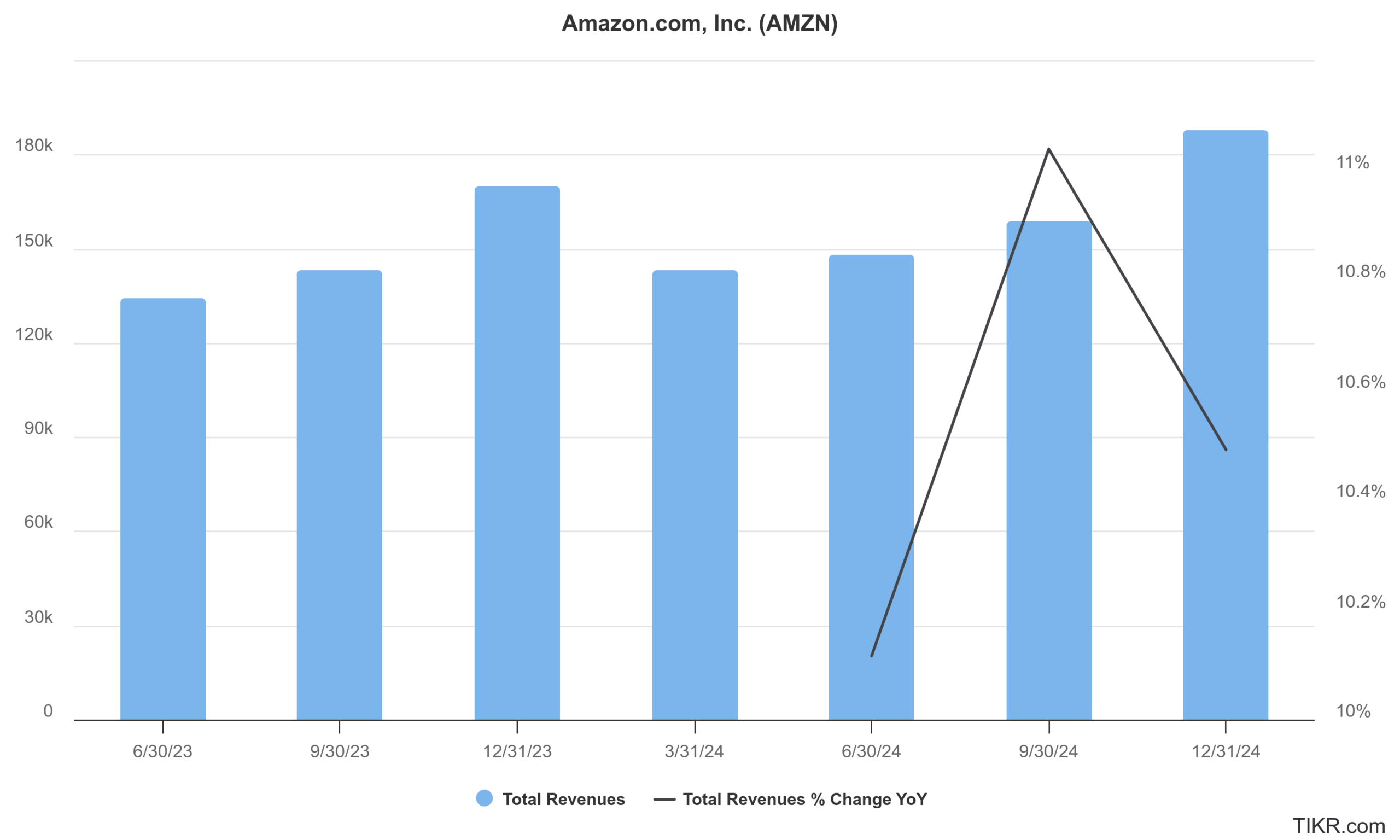Amazon Provides Soft Guidance Amid Tariff Uncertainty
Please note that we are not authorised to provide any investment advice. The content on this page is for information purposes only.
Amazon (NYSE: AMZN) released its Q1 2025 earnings yesterday after the close of markets. While the company beat Q1 earnings estimates, its Q2 guidance spooked investors. Here are the key takeaways from the company’s Q1 report and analysts’ reaction.
Amazon’s Q1 revenues rose 9% YoY to $155.7 billion and were ahead of the $155.04 billion that analysts were expecting. However, Amazon Web Services (AWS) revenues came in at $29.3 billion, which while up 17% YoY fell short of the $29.47 billion that analysts were modelling.
AWS is Amazon’s most profitable segment, but its revenue growth has now missed consensus estimates for three consecutive quarters.
Amazon Reported Better-Than-Expected Earnings
Amazon’s operating income rose to $18.4 billion in Q1 compared to $15.3 billion in the corresponding quarter last year. The company’s operating income was ahead of its guidance of between $14 billion to $18 billion.
Looking at the different business segments, the North America segment’s operating income rose from $5 billion to $5.8 billion, while the International segment’s operating income rose from $0.9 billion to $1 billion. AWS reported an operating income of $11.5 billion compared to $9.4 billion in the corresponding quarter last year. The company’s EPS rose from $0.98 to $1.59 over the period and easily surpassed the $1.36 that analysts were expecting.
“We’re pleased with the start to 2025, especially our pace of innovation and progress in continuing to improve customer experiences,” said Amazon CEO Andy Jassy during the earnings call.
Amazon Provided Light Guidance
Amazon expects its Q2 revenues to be between $159 billion and $164 billion, which implies a YoY rise between 7% and 11%. It forecast operating income between $13 billion and $17.5 billion, which fell considerably short of estimates at the midpoint. The company emphasized that its “guidance considers a range of possibilities and takes into account Q1 results, trends in quarter-to-date results and expectations around the macroeconomic environment.”
Among others, it listed “global economic and geopolitical conditions, tariff and trade policies, and customer demand and spending (including the impact of recessionary fears)” as the factors that could impact its results in the quarter.
Notably, the impact of tariffs is among the key talking points during the recent earnings calls. In response to an analyst’s questions about the tariffs, Jassy said, “It’s hard to tell what’s going to happen with tariffs right now. It’s hard to tell where they’re going to settle and when they’re going to settle.”
He added, “And so a lot of what we’re thinking about short and medium term, actually turns out to be what we think about long-term, too, which is how do we actually have the broadest possible selection for customers at the lowest possible prices, and there’s maybe never been a more important time in recent memory than trying to keep prices low.”
Pointing to the market share gains during the COVID-19 pandemic, Jassy said that Amazon could emerge even stronger once the tariff uncertainty dies down.
Amazon Has Built Some Inventory to Offset Tariffs
To offset the tariffs, several US companies imported in advance and built considerable inventory ahead of the tariffs. During the Q1 earnings call, Jassy said, “We’ve done some forward buys of inventory where we’re the first-party seller. Our third-party sellers have pulled forward a number of items, so they have inventory here as well. And those are all we’re encouraging that because we’re trying to keep prices as low as possible for customers.”
While higher inventory would help negate the impact of tariffs for some time, it won’t be a long-term fix considering the uncertainty over the tariffs.
“I can’t imagine that they stocked up on more than six months’ worth of inventory,” said D.A. Davidson analyst Gil Luria.
He added, “If we get past the next six months and we’re still as uncertain as we are today … then Amazon will have to take actions that are less palatable. It’s gonna have to let some higher prices flow through, take some lower margins structurally, have to push its merchants to absorb lower margins.”
Commenting on the guidance, Luria said, investors “may be a little disappointed by margins and margin guidance, which could create a concern about Amazon absorbing tariff costs. While AWS grew almost as expected, that comes on the tail of Microsoft Azure well exceeding expectations and growing that business almost twice as fast.”
Tariff Impact Might Hit AMZN Beyond Q2
Meanwhile, while Amazon might still largely dodge the tariff bullet in Q2, it could impact its earnings in the coming quarters. As Bob O’Donnell, president and chief analyst at TECHnalysis Research, said, “I think the worst of this is going to hit in Q3 and Q4. Right now, everybody’s playing sort of the short-term game because they don’t really know what else to do.”
UBS analyst Stephen Ju estimates that over half of the products sold on Amazon will face a tariff-related price increase in one form or the other.
In his note, Ju wrote, “Consumers therefore might have to make more difficult choices on where to allocate their dollars.”
He added, “We also have to think that there could be second order impacts as exporters to the US are likely going to face lower revenue and as a result may have to make adjustments to their business/headcount needs, which may impact employment globally and downstream [gross merchandise value] growth internationally as well,” Ju added.
Recession Fears Rise
Several economists have warned of a recession amid the escalating global trade war. JPMorgan for instance has raised the odds of a US recession this year to 60% as compared to 40% before the tariff announcement. In his note, Bruce Kasman, head of global economic research said, “These policies, if sustained, would likely push the US and possibly global economy into recession this year.”
Allianz’s Chief Economic Advisor, Mohamed El-Erian, has also warned about the growing risk of a recession.
Separately, a Deutsche Bank survey shows a nearly 50-50 chance of a recession. UCLA Anderson Forecast has also recently issued its first-ever recession watch amid concerns over Trump’s policies.






